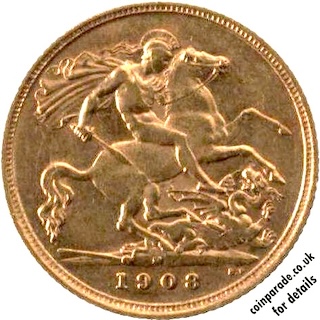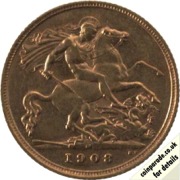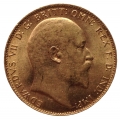
 The 1908 Gold Half-Sovereign Melbourne - Edward VII
The 1908 Gold Half-Sovereign Melbourne - Edward VIIThe 1908 Melbourne Half-Sovereign depicts Benedetto Pistrucci’s famous portrayal of St George slaying the dragon on the reverse of the coin
A small 'M' above the date indicates the sovereign was produced in Melbourne, Victoria, Australia.
 King Edward VII’s bare head portrait, by George W. de Saulles, can be seen on the obverse of the coin.
King Edward VII’s bare head portrait, by George W. de Saulles, can be seen on the obverse of the coin.Image credit: Museums Victoria
Mintage: Not known
Minted at The Melbourne Mint
Below are some coins currently being offered on eBay. As an eBay Partner, We may be compensated if you make a purchase.
 Edward VII was King of the United Kingdom and the British Dominions and Emperor of India from 22 January 1901 until his death in 1910. Edward was the eldest son of Queen Victoria and Prince Albert of Saxe-Coburg and Gotha. Edward married Princess Alexandra of Denmark in 1863.
Edward VII was King of the United Kingdom and the British Dominions and Emperor of India from 22 January 1901 until his death in 1910. Edward was the eldest son of Queen Victoria and Prince Albert of Saxe-Coburg and Gotha. Edward married Princess Alexandra of Denmark in 1863.Five Pound, Two Pound and Crowns were only released in 1902. The 1902 Proof set for the Coronation is unusual in that it had a Matt finish. Gold Sovereign mintages were high during the reign of Edward VII, averaging more than 10 million per year which makes them fairly common even today.
The Half-Sovereign wa introduced a long time ago, in 1544 during the reign of Henry VII. However it was discontinued in 1604 (along with full sovereigns) and no more were minted until 1817. Production ended again in 1926 (1933 in Australia) and except for a few special issues during the Coronation years, it was 1980 when we saw half-sovereigns again.
As the value is half of one sovereign, that gives the half-sovereign a face value of half a pound or ten shillings - 50p in post-decimal money, although you're going to have to pay somewhat over the gold price if you want to buy one.
The Obverse is the Monarch's head (Edward VII) and on modern half-sovereigns the Reverse is most often St George and the Dragon (usually the Benedetto Pistrucci version), although other backs have been used.
Specifications for 1908 Gold Half-Sovereign Melbourne - Edward VII
- Weight: 3.99 g
- Diameter: 19.30 mm
- Thickness: 0.99 mm
- Purity: 22 carat = 91.67% (11/12ths gold, 1/12th copper. Adding copper makes the coin more scratch and dent resistant)
- Gold Content: 3.6575 g = 0.1176 troy ounce
- Face value: £0.50 = 10 shillings (decimal: 50 pence)
- Monarch: Edward VII
- These specifications apply to half-sovereigns from 1817.
History
Up until 1604 there was a coin called the English gold sovereign and in 1816 when there was the "Great Recoinage" the name was revived. At that time standard gold (22 carat) was valued at £46 14s 6d per troy pound; this meant a £1 coin needed to weigh 123.2744783 grains or 7.988030269 g. The weight is still the same today.
As a historical note: to maintain the Gold Standard, in 1816 the value of silver was set at 66 shillings for one troy pound and silver coins were only legal for denominations up to £2. The diameter of a half-sovereign is 19.3mm and is only slightly smaller than a full sovereign (22.05mm) so first appearance may confuse inexperienced buyers. You can see in the image on the right, the half-sovereign on the right hand side is quite similar to the full sovereign on the left.
The diameter of a half-sovereign is 19.3mm and is only slightly smaller than a full sovereign (22.05mm) so first appearance may confuse inexperienced buyers. You can see in the image on the right, the half-sovereign on the right hand side is quite similar to the full sovereign on the left.
While you can buy half-sovereigns, many collectors only own them as part of a set.
The orignal coinage was Pounds, Shillings and Pence but since decimalisation on 15 February 1971, it is £1 = 100p, that is One Pound = 100 pence. The coinage of the UK is also a long history, the Royal Mint being established as long ago as 886AD when coins were hammered. Today there is perhaps 30 billion coins in circulation, and many (numismatic) collectors coins and sets are issued frequently in gold, silver and other metals.
As an eBay Partner, We may be compensated if you make a purchase.








